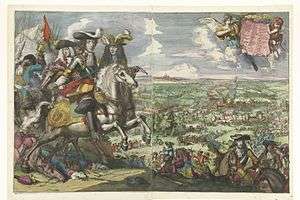Battle of Saint-Denis (1678)
| Battle of Saint-Denis | |||||||
|---|---|---|---|---|---|---|---|
| Part of the Franco-Dutch War | |||||||
 Battle of Saint-Denis - a print from Romeyn de Hooghe | |||||||
| |||||||
| Belligerents | |||||||
|
|
| ||||||
| Commanders and leaders | |||||||
|
|
| ||||||
| Strength | |||||||
| 40,000 | 40,000 | ||||||
| Casualties and losses | |||||||
| 2,500 killed or wounded | 4,500 killed or wounded | ||||||
The Battle of Saint-Denis was fought on 14–15 August 1678 between a French army commanded by the Marshal Luxembourg and a Dutch army under William III near Saint-Denis, a village outside Mons, then part of the Spanish Netherlands (now Belgium). It was the last battle of the Franco-Dutch War (1672–1678), fought after the peace was signed between France and the Netherlands in the Treaty of Nijmegen on 10 August.
The treaty between France and Spain was not yet signed, and it was the intention of the French to make further pretexts for delay, in the hope that Mons meanwhile would fall. The report of the conclusion of peace reached the stadholder in his camp on 13 August, but unofficially. On the morning of 14 August D’Estrades came personally to bring the news to Luxemburg; and the French marshal was on the point of forwarding the message to the Dutch camp, when he heard that Orange was advancing with his army to attack him, and he felt that honour compelled him to accept the challenge. A sanguinary fight took place at Saint-Denis, a short distance from Mons. William exposed his life freely, and though the result was nominally a drawn battle, he achieved his purpose. Luxembourg raised the siege of Mons, and the negotiations with Spain were pressed forward. The treaty between France and Spain was signed on 17 September 1678.
The battle was one of the most fiercely contested of the whole war.
Present at the battle
James Scott, 1st Duke of Monmouth, the illegitimate son of Charles II of England, was present at the battle as commander of the Anglo-Dutch brigade, and distinguished himself.
Also present were Menno van Coehoorn (the “Dutch Vauban”), and the future Marshal Hendrik Overkirk, who is said to have saved the life of William III during the battle by cutting down an attacker who already had his pistol against the Prince’s chest.
Notes
- ↑ Dupuy (1986), p. 566
- ↑ Sandler (2002), p. 514